Do you know how to shop for beer? I don’t mean grabbing a six-pack off the shelf and exchanging it for money—anyone with enough years behind them or, ahem, a plausible ID can do that—but earnestly shopping for the best, freshest beer available? Like knowing which stores stock the freshest cans, have the highest turnover of inventory, or get the rarest selection of bottles?
Consumers are often overwhelmed with choice when they walk down the beer aisle. We’ve all been there, staring at row after row of beer, wondering which IPA to choose of the dozen or so available, trying to guess and conjure flavors based on terse descriptions and flowery language. It can get downright tiresome.
To help you get the best beer available, here are suggestions on how and where to shop for beer, and which beers to buy where. Of course, this all depends on where you live and what you have access to, but let’s assume you have a local supermarket, a bottle shop, a brewery, and access to the web.
FIVE TIPS FOR EXPERT BEER SHOPPING
1. BUY THE FRESHEST BEER POSSIBLE
Often that means choosing regional or local beers over imports or national brands, and favoring stores with high turnover to ones whose inventory doesn’t move quickly.
2. NOTICE HOW THE BEER IS KEPT.
Most beer should be stored cool or cold, and all beer should be kept out of direct sunlight. If you see a store with bottles in direct sunlight, avoid shopping there.
3. SHOP AT DIFFERENT LOCATIONS FOR DIFFERENT BEERS
Different outlets specialize in different styles and products, and nearly all retailers have their strengths and weaknesses. Use this variety to your advantage.
4. CHECK THE DATE CODE.
Know how to locate a beer’s code, indicating when the beer was bottled. If you spot an expired or out-of-date beer on the shelf, don’t shop there.
5. DON’T BE AFRAID TO ASK QUESTIONS
Even if you shop for beer at a grocery store, chances are the person in charge of ordering that beer can answer your questions. At bottle shops or breweries the staff will be more than willing to geek out with you on hops or provide precise recommendations for bottles and styles.
WHERE TO SHOP
SUPERMARKETS
Large supermarkets are increasingly decent options for purchasing good beer. Most stock the big national and international brands, and move through inventory quickly. They also stock national and regional craft beer, and may even offer a selection from local breweries. Often, you can mix and match six packs of individual bottles or cans, a great option for testing new beers without committing to an entire six-pack or case.
WHAT TO BUY: MIXED SIX PACKS; NATIONAL AND REGIONAL CRAFT BEERS; MACROBREWS IN QUANTITY
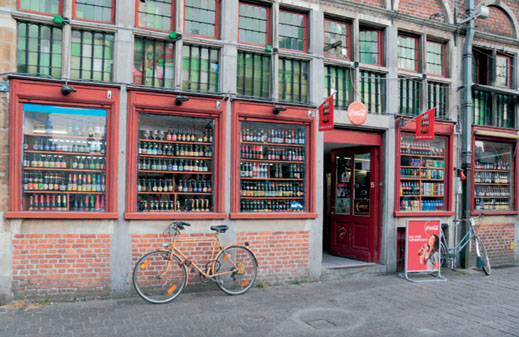
A bottle store in Ghent, Belgium
Photo: Alamy: Maurice Savage
BOTTLE SHOPS
Specialty beer shops typically have a wider, more diverse selection than supermarkets. They stock beer from small, esoteric breweries and are staffed by knowledgeable, passionate beer geeks. (Shop at one enough and you’ll likely develop a rapport with the staff, which comes in handy for special releases and when you’re seeking new recommendations.) Some even offer draft beer to go in glass jugs called growlers or large, single-use cans called Crowlers™—the beer is poured and sealed to order. A popular twist on this model is the bottle shop–cum–beer bar, which allows drinkers to knock back pints on premise and take beer to go.
WHAT TO BUY: ESOTERIC BOTTLES; SPECIAL RELEASES; GROWLERS AND CROWLERS™
BREWERIES
For the freshest beer, go straight to the source. Most breweries sell beer directly to imbibers, either in a tasting room or retail shop. And even if your local spot doesn’t offer packaged, bottled, or canned beers, most will fill a growler for you to take home. A bonus? Since the intermediary is removed, you’ll pay the lowest prices, while directly supporting a local business.
WHAT TO BUY: PINTS IN THE TASTING ROOM; RARE AND ONE-OFF RELEASES; GROWLERS AND CROWLERS™
ONLINE
The explosion of online beer sellers means many once hard-to-find bottles are just a click or two away. Of course, delivery depends on whether your municipality allows delivery of alcohol, but for the most part, beer from far-flung locales is no longer necessarily difficult to acquire. Be sure to order from a reputable source, though—some online retailers stock old, stale beer that’s spent far too much time collecting dust in the warehouse.
WHAT TO BUY: BEER NOT DISTRIBUTED TO YOUR REGION; VINTAGE BEER; HARD-TO-FIND BOTTLES
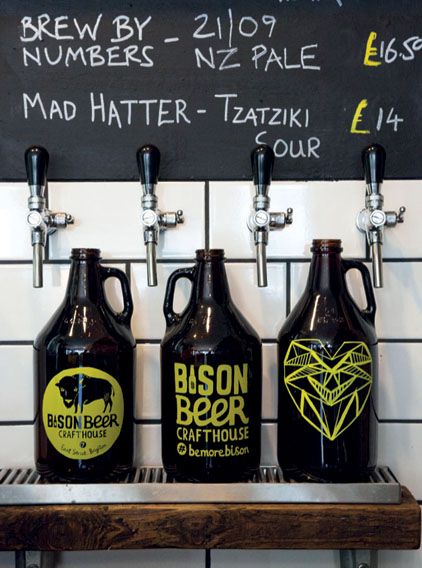
Growlers in Bison Beer Crafthouse, Brighton, UK
Photo: Louie Londt
DATE CODING
Most beer is tagged with a stamp indicating when it was packaged or when it is best consumed by. These are called date codes, and if you know how to spot and decode them, they can help you purchase the freshest beer possible.
Date codes vary wildly across breweries and locales, and deciphering them can be tricky. The most straightforward ones will clearly state the day, month, and year on which the beer was packaged. Others indicate a “Best By” date, which typically means 90 to 120 days after packaging. The worst examples use cryptic Julian calendar dates that indicate the numbered day of the year followed by the last digit in the year. For example, a beer packaged on February 1, 2017, would obtain the code “0327”. Other codes are notched on the label, indicating with a tick mark or small groove the month and day on which the beer was packaged. Some beers have no date code at all.
VINTAGE BEER
Although you should avoid expired or out-of-date beer for most styles, that isn’t always the case. In fact, some beers improve with age. Age-able beers will keep for years, progressing and evolving right in the bottle.
SERVING TEMPERATURE
These are temperatures at which different types of beer should be poured. Inevitably, the liquid will warm in the glass as you sip, which is a good thing, because it encourages flavors to unfurl and evolve.
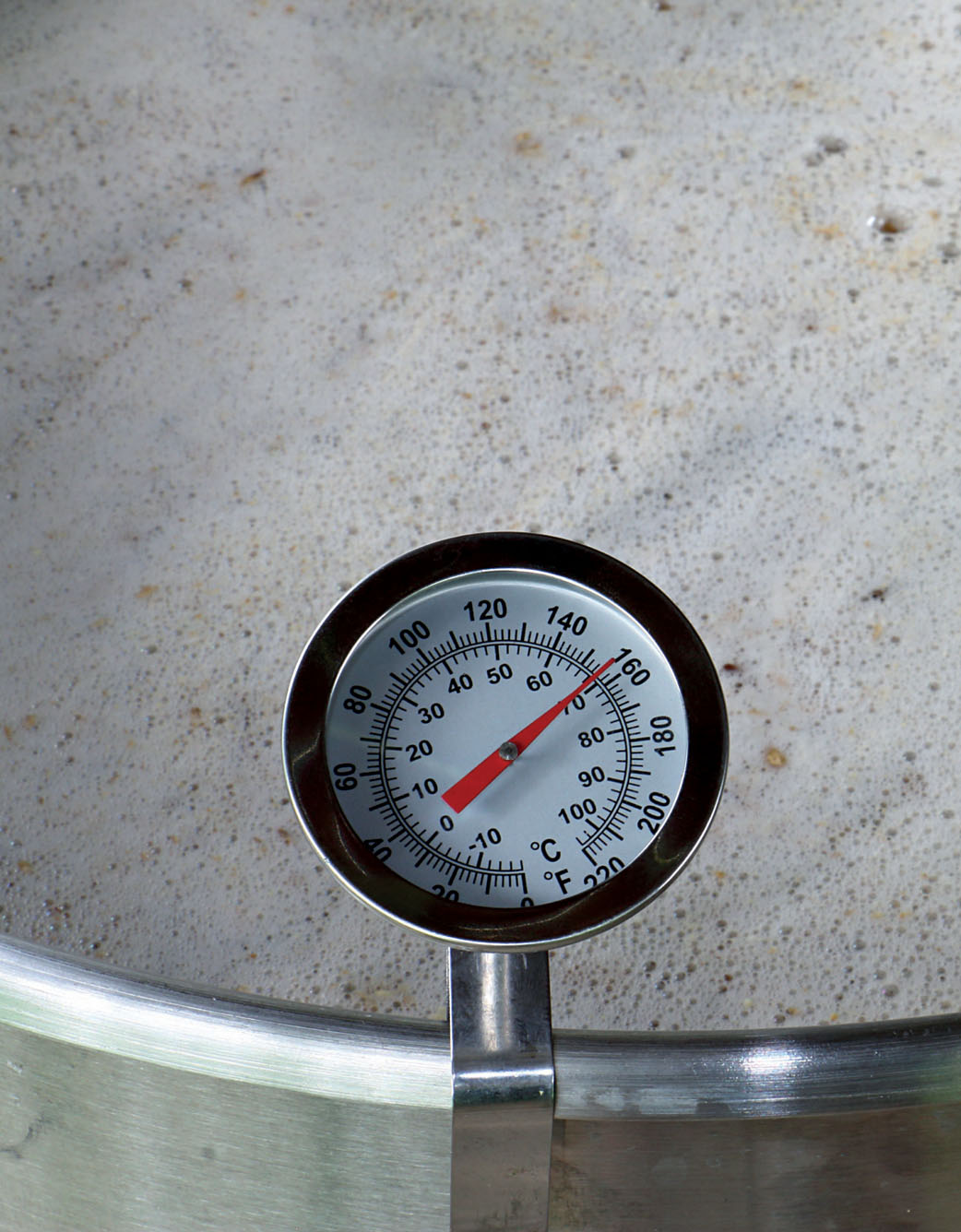
55ºF: IMPERIAL PORTER AND STOUT BARLEYWINE BELGIAN QUAD
45ºF: SAISON AND FARMHOUSE PORTER AND STOUT IPA
40ºF: PILSNER AND LIGHT LAGER PALE ALE KÖLSCH
Photo: iStock: akinshin
BUILDING YOUR OWN BEER CELLAR
Now that you know how to shop for the best beer available, it’s time to think about how to keep it. For beer intended to be consumed fresh, nothing’s better than a standard 40°F refrigerator. Kept in such conditions and consumed within a few weeks or up to a month, the beer should taste vibrant and bright. But for beer you plan to age, you’ll want a dark, cool environment that fosters flavor development and evolution.
WHY AGE BEER?
Aging encourages beer’s inherent flavors to expand and evolve right inside the bottle, resulting in a transformed, multilayered, and (hopefully!) delicious brew. Part of the fun of collecting beer is tasting it during an arch of evolution. There’s no better way to do that than with a home cellar.
BUILDING YOUR INVENTORY
What are the best beers to stock in your cellar? In general, if it’s dark and boozy, you can age it. Think barleywines, Russian imperial stouts, and Trappist quads. Sour ales with funky bacteria—Belgian lambics, for example—age remarkably well, too, as do many saisons and farmhouse ales inoculated with Brettanomyces. In fact, nearly all sours are good candidates for aging because the yeast will continue to develop and alter the beer’s flavors while the bottle is being stored.
This may sound ridiculously obvious, but avoid aging beers that are best consumed fresh—that means light, delicate ones like pilsners and fresh IPAs. Their ephemeral aromas and flavors dissipate within weeks and are all but obliterated after months. That’s not to say they won’t taste good after a prolonged sojourn in the cellar; they just won’t be at their prime.
CONSTRUCTING YOUR CELLARING SPACE
An ideal aging environment is a cool, dark spot with a constant temperature of around 55°F. If you’re fortunate enough to have a natural space like this at your disposal—say, an actual real-life below ground cellar—by all means, use it to age beer. But if, like me, you live in a minuscule apartment with nary a shelf to spare, you’ll need to be more imaginative.
A decent cellaring space can be as simple as a box in the back of a closet. Or it can be a high-tech climate-controlled room. You’re likely to settle for something in between, but regardless of scale and scope, a handful of factors are common to creating a friendly beer-aging situation.
First, the space should be dark. Direct sunlight initiates a chemical reaction in beer that causes it to “skunk.” Second, it should be in the Goldilocks zone of temperatures: neither too cold nor too hot. Fridge-like conditions inhibit beer’s ability to evolve over time, while high temperatures and wild fluctuations can lead to off flavors.
The position in which your bottles are stored is another consideration. Some breweries age their beers horizontally, but for home collectors, storing your bottles upright is the best practice. (This minimizes the surface area of beer exposed to oxygen that may be in the bottle.)
HOW TO GET STARTED
Set a budget for both beer and equipment. If you can afford a wine fridge, buy one. If not, find a space in your home that’s dark and cool where the beer can be kept pretty much undisturbed for months or even years.
Then buy as many different bottles as you can. Stock up on multiples of a single beer—part of the fun of cellaring is tasting and tracking a beer as it ages over time. I recommend buying three bottles of any beer you intend to cellar. Open one bottle immediately and make notes on how it tastes. In six months, open another bottle and describe how it’s changed. This should give you a good perspective on how the beer might evolve going forward. The third you can keep for as long as you like, up to several years.
Remember: longer is not necessarily better. Two to four years is usually the maximum for storing most beers, though some are excellent at five and even ten years of age. As soon as you think the beer is not as good as the last time you drank it, it’s probably not going to rebound. At that point it’s time to sup up and drink the rest of those beers.
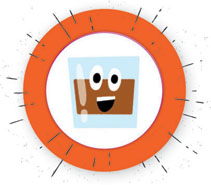
Beer can be stored in barrels that once held whiskey
Illustration: Tyler Gross
FIVE BEERS TO GET YOU STARTED
BOON OUDE GEUZE MARIAGE PARFAIT—GEUZE
This supremely tart 100 percent spontaneous ale blends young and old lambic. It’s zesty with flavors of green apple, lemon, and hay. Brewed with aged hops, it will mature and evolve beautifully for many years.
SIERRA NEVADA BIGFOOT—AMERICAN BARLEYWINE
Bigfoot is the everyman of aged beer—inexpensive, available at many supermarkets, and fortified with huge quantities of malt and hops whose flavors become robust and sherry-like over time.
STONE ENJOY AFTER—BRETT IPA
IPAs conditioned with Brettanomyces are suitable for aging. Developed as an antidote to the brewery’s ultra-fresh Enjoy By series, this is primed with Brettanomyces and intended for aging for many months past the Enjoy After date.
RODENBACH GRAND CRU—FLANDERS RED ALE
This Belgian Flanders red is a blend of young and aged beer. Its flavors are tart, fruity, and complex with a smooth finish that only gets softer and richer with age.
FIRESTONE WALKER PARABOLA—RUSSIAN IMPERIAL STOUT
Nearly all imperial stouts are suitable for aging, but this one is a favorite. The beer is aged for a year in bourbon barrels before bottling. With age, the alcohol mellows and the beer becomes velvety and chocolaty, with notes of vanilla and charred oak.

Illustration: Leigh@KJA Artists

Photo: Louie Londt
GLASSWARE
Order a draft beer at nearly any bar or restaurant and chances are it will be delivered in a 16- or 20-oz, thick-walled, slightly downward-tapering shaker glass. It’s the world’s most ubiquitous beer glass because it’s easy to stack and difficult to break, making it a favorite for bartenders and bar owners alike.
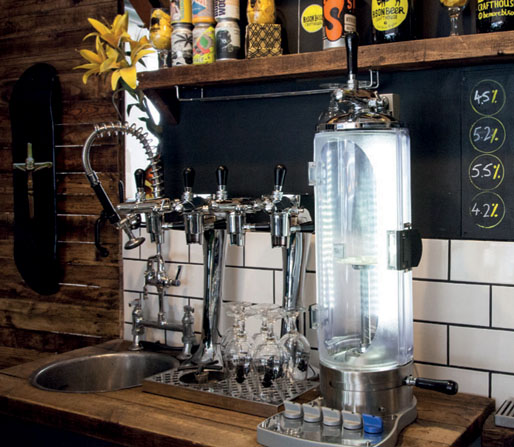
These tulip-shaped beer glasses are ready and waiting
Photo: Louie Londt
Unfortunately, it also happens to be one of the worst vessels for tasting beer. First, the wide mouth dissipates rather than concentrates the beer’s aromas, making the beer smell flat and insipid. Second, its thick walls deliver the liquid to all the wrong areas rather than guiding it to the sweet center of your palate. This is okay for some beers, but the one-size-fits-all pint just won’t cut it.
So, what are the best glasses to use? It depends on the beer. Lighter ones like pilsners, wheat ales, and most IPAs are best dispensed into a tall glass with a slight taper at the brim. Rich, intensely flavored beers like barrel-aged stouts and barleywines are partial to squat, bulbous snifters—the kind your grandfather might have sipped Scotch from.
The market is flooded with options, so here are a few general guidelines to keep in mind when buying glasses for your home:
CHOOSE VERSATILITY OVER SPECIFICITY
Some companies market glasses for each style like IPAs, stouts, wheat beers, and pilsners. While most of these are well crafted and elegant, they simply aren’t necessary and will inevitably crowd your cupboards. Choose two or three versatile glasses you can use across a range of styles and flavors.
THINK SLEEK AND CLASSIC, NOT CLUMSY AND TRENDY
A classic thin-lipped wineglass will get way more beer mileage in my house than a dimpled mug or shaker pint. And unless you’re throwing a rowdy Oktoberfest rager, don’t even think about dusting off the beer boot!
THREE GLASSES TO OWN
WILLI BECHER GLASS The Willi Becher glass is a German design most commonly used for pilsners and other light, sessionable beers. It comes in a variety of sizes, but the 500 ml (16 oz) is best for most lagers, IPAs, and everyday porters and stouts. The slight conical taper at the top concentrates flavors and projects bright, fresh aromas from the light surface directly to your olfactory zones.
![]()
Original illustration by Skatin Chinchilla
CLASSIC WINEGLASS No, it isn’t pretentious to put beer in a wineglass! Especially if you’re drinking a fruity, effervescent saison from Belgium or a light-bodied simple sour from Germany or the US. Not only is it the perfect size for beer (comfortably holding around 8 to 10 oz of liquid), the stem prevents your hand from warming the beer as you hold it. Need more proof? Basic wineglasses are increasingly the go-to stemware at serious beer bars throughout the world.
![]()
Original illustration by Skatin Chinchilla
SNIFTER GLASS For big beers like imperial stouts, barleywines, and Belgian quads, choose a snifter glass. Strong, aggressive flavors require small pours at relatively warm temperatures (around 55°F). This makes them perfectly suited for a round, short-stemmed snifter like the kind used for bourbon, brandy, or cognac. The balloon shape focuses volatile aromas that would otherwise dissipate in an open-topped glass, while allowing the beer to unfurl and develop as it warms in the glass.

Original illustration by Skatin Chinchilla
AND ONE GLASS THAT CAN DO EVERYTHING . . .
If you had to choose one glass that works for every beer style imaginable, from the lightest lagers to the burliest barleywines, it would be the Spiegelau Beer Tulip. It’s the most versatile glassware in the world, with a thin rim and a generous but tapered shape that makes practically any beer you pour into it seem like a revelation. It combines the best traits of the three glasses into a single vessel.
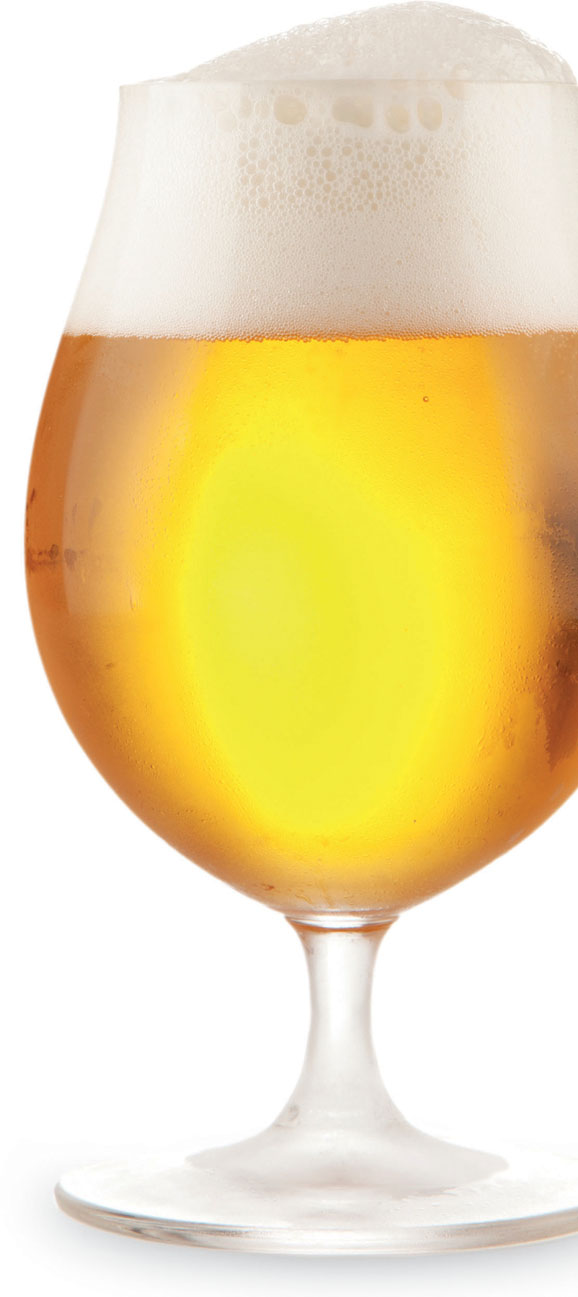
Photo: iStock: GeorgeDolgikh
Original illustration by Skatin Chinchilla
A BEER-TASTING PRIMER
Now that you know how to shop for, store, and serve beer, it’s finally time to taste it! Hurrah! Here, we break beer tasting down into five primary components for consideration when evaluating beer.
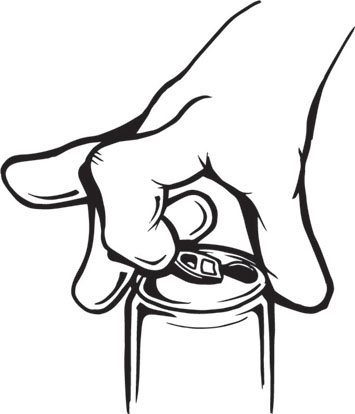
Original illustration by Skatin Chinchilla
First, though, you’ve got to get it into the glass. The best way to pour beer is to tilt your glass at a 45° angle and pour slowly against the glass’s wall. As you pour, gradually bring the vessel upright and finish with a parting shot directly in the center of the liquid. Be sure to leave some room in your glass for sniffing—don’t fill it all the way up!
Note: Most beer is gassed to a normal Budweiser-level carbonation, but some—especially saisons, farmhouse ales, and mixed-culture beers—can have very high levels of carbon dioxide. Sometimes they even gush out of the bottle when the cap or cork is pulled! (These are called gushers.) Open these styles over or near a sink in case of eruption. Such beer may also contain yeast sediment at the bottom or along the length of the bottle, depending on how it’s been stored. Don’t drink the sediment if you don’t want to, but know that’s it’s full of good-for-you nutrients and Vitamins B1, B2, and B12.
NOW IT’S TIME TO TASTE.
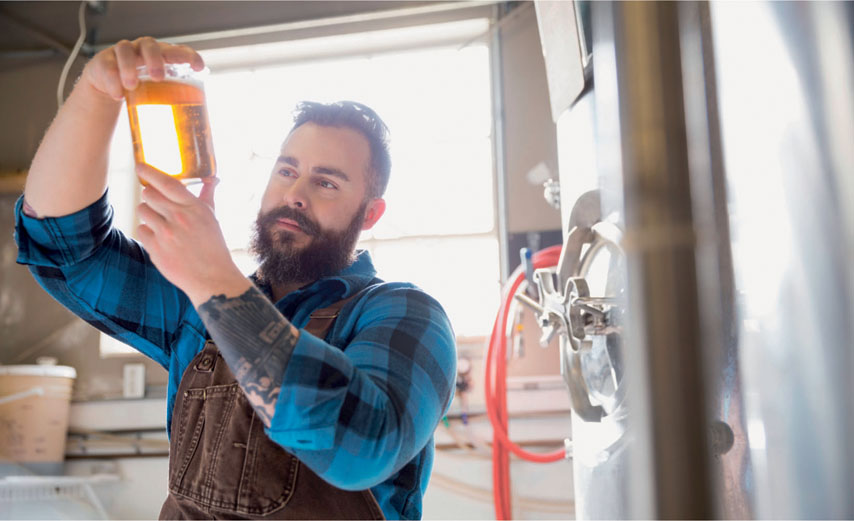
Evaluate the clarity of the beer by holding it up to the light
Photo: Alamy: Hero Images Inc.
1. LOOK AT THE BEER. Hold it up to a light. Notice its color and clarity. Is it hazy and cloudy or bright and clear? Does it have a fluffy, cloud-like head or a thin, soapy film? Does the liquid itself look clean? Is there anything particularly unusual about its appearance? (Is it hot pink or magenta, for instance? If so, it probably contains fruits or flowers.) Make notes or describe it to a friend.
2. SMELL IT. Get your nose in there, breathe deeply and inhale with your lips shut. Swirl it around the glass a little so that more aromas are released. Then sniff it again. Keep doing this until you’re ready to taste it. Think about what you’re smelling and describe it to a friend.
3. TASTE IT. Sip the beer and hold it in your mouth. Don’t swish it around the way you would wine or mouthwash, but think about it and consider what flavors you’re tasting. Breathe through your nose and notice how the beer is changing. “Chew” on it some more and then swallow. What’s the finish like? Does it taste the same or remarkably different from the first sip? Note what flavors you’ve experienced and how the taste changes over time.
4. FEEL IT. Did the beer seem viscous and sticky on your palate or was it thin and watery? Maybe somewhere in between? Was it spicy and prickly at all, or creamy and smooth? Maybe there was little or no carbonation. All these factors can indicate what base grains were used, how boozy the beer is, and how it was fermented.
5. OVERALL IMPRESSIONS ARE IMPORTANT. Do you like it? If so, can you describe why? Or did it literally leave a bad taste in your mouth? Did all the components sing together in harmony or did one or two stick out like a squeaky wheel?
GRAINS OF TRUTH
Have you properly soaked up this chapter’s pearls of wisdom on how best to store beer and savor its flavor? To find out what you’ve learned—and how well you’ve learned it—pick out which of the following statements are true or false . . .
1. NO BEER EVER IMPROVES WITH AGE.
2. IF YOUR STORE OR CELLAR IS REGULARLY EXPOSED TO DIRECT SUNLIGHT, THAT’S ABSOLUTELY FINE.
3. IT’S BEST TO STORE BOTTLES UPRIGHT RATHER THAN HORIZONTALLY.
4. THICK-WALLED, TAPERING SHAKER GLASSES ARE SOME OF THE BEST FOR HELPING YOU PICK UP BEER FLAVORS.
5. YOU ONLY REALLY NEED THREE VERSATILE TYPES OF BEER GLASS IN YOUR KITCHEN TO COVER THE FLAVOR SPECTRUM.
6. IT’S A VERY BAD IDEA—NOT TO MENTION PRETENTIOUS—TO DRINK BEER FROM A WINE GLASS.
7. THE SPIEGELAU BEER TULIP IS THE MOST VERSATILE GLASS IN THE WORLD.
8. SAISONS, FARMHOUSE ALES, AND MIXED-CULTURE BEERS TEND TO HAVE LOW LEVELS OF CARBON DIOXIDE, SO THEY’RE QUITE UNLIKELY TO GUSH ON YOU.
9. AVOID DRINKING SEDIMENT AT ALL COSTS. I MEAN, BLEURGH—THERE’S NO NUTRITIONAL OR FLAVOR VALUE IN IT WHATSOEVER.
10. A HOT PINK OR MAGENTA TONE THROUGHOUT A BEER USUALLY SIGNALS FRUIT OR FLOWER CONTENT.
11. THE STRONG, AGGRESSIVE FLAVORS OF IMPERIAL STOUTS AND BARLEYWINES ARE BEST ENJOYED FROM SMALLER POURS.
12. OPEN-TOPPED GLASSES HELP YOU GET THE MOST OUT OF VOLATILE AROMAS BY SETTING THEM FREE.
13. PALE ALE SHOULD IDEALLY BE SERVED AT AROUND 55ºF.
14. IPAS ARE BEST SERVED AT AROUND 45ºF.
15. BOTTLED BEERS ARE THE BEST ONES TO DRINK IN A NICE, HOT SHOWER.
SHOWER BEERS
One of the simplest pleasurable acts in the world is enjoying an ice-cold beer while taking a steaming hot shower. Indulgent? Yes. Gratifying? Absolutely. Uncouth? Definitely. But you’re an adult, and you make your own decisions.
Whether it’s to unwind after a hard day’s work or to pregame for a big night out, the unadulterated delight in this basic but satisfying act is simply unparalleled. Here are some guidelines for optimizing your shower sipper.
1. CAN IT. Showers are slippery, slick places full of liquids, lotions, soaps, and suds. So grab a canned beer instead of a bottle. Cans are easier to grip anyway, and if you happen to drop your beer—a severe enough tragedy in and of itself—at least you won’t wind up with a bathtub full of shattered glass.
2. CHOOSE LIGHT. Unless you’re really trying to pregame hard, stick with a beer below 5 percent ABV and you’re much less likely to stumble out of the shower.
3. MAKE IT A TREAT. Shower beers should be an occasional treat, not part of your daily grooming routine. Although it may be tempting to indulge on a regular basis, the novelty will quickly wear off if you make it a regular occurrence.
4. TAKE YOUR TIME. That said, when you do indulge, take your time! After all, this is supposed to be a pleasurable, satisfying act. Your olfactory senses will already be heightened from the steam and multifarious shower smells, so it’s a great opportunity to meditate on your beer’s qualities.
SO GO AHEAD—TREAT YOURSELF—AND GRAB A SHOWER BEER NEXT TIME YOU’RE ABOUT TO SLIP BEHIND THE CURTAIN.
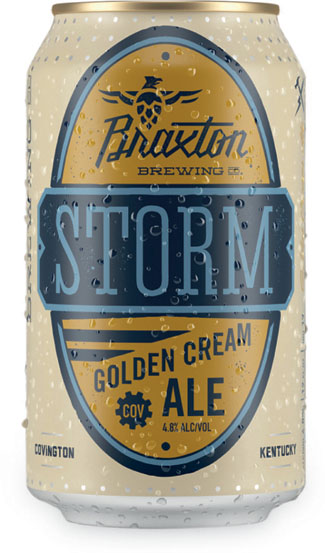
Photo: Alamy: Will Stanton
Brewery: Braxton Brewing Co